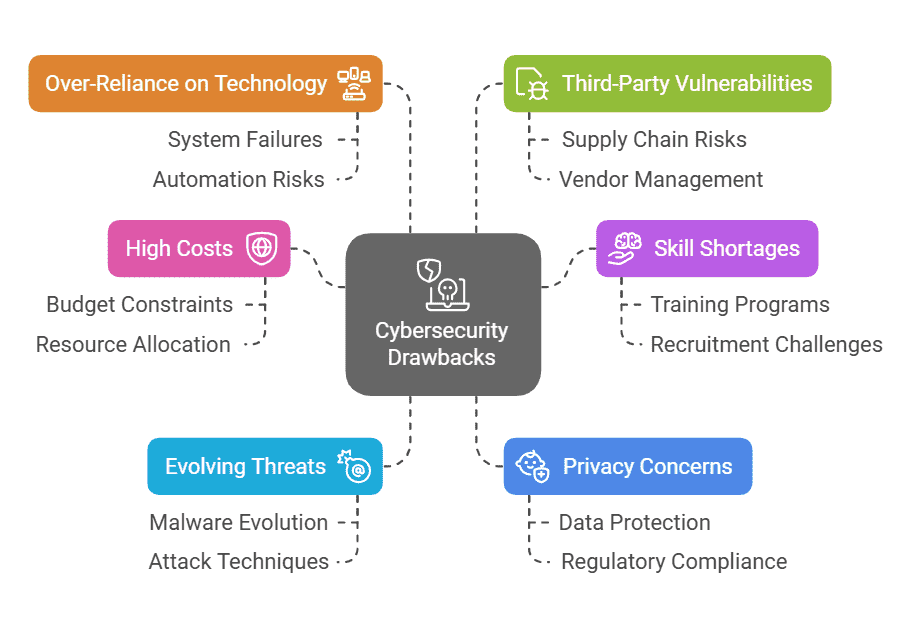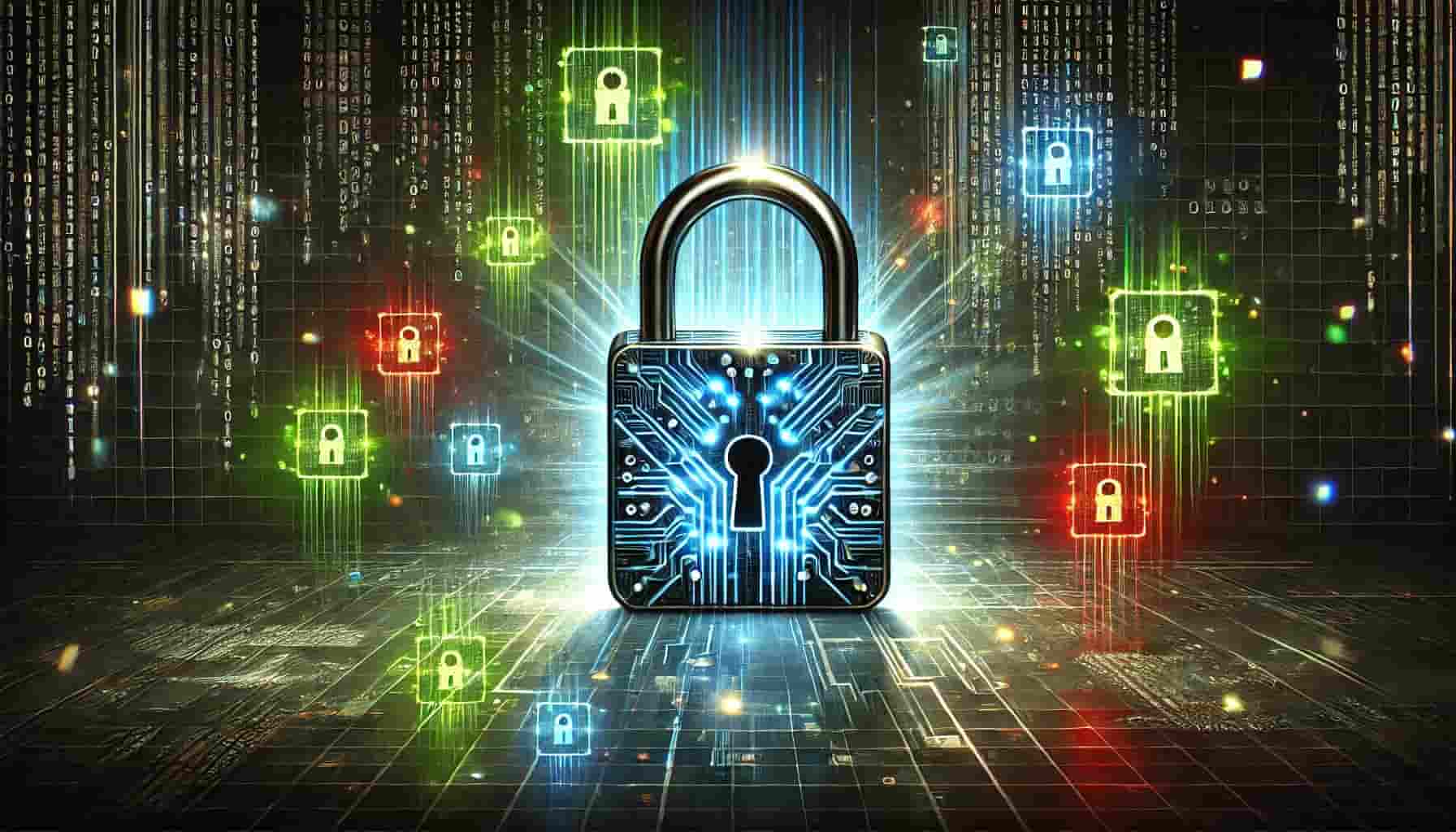Introduction: Why Cybersecurity is More Important Than Ever
In today’s world, we rely on technology for nearly everything—shopping, banking, working, and even socializing. This makes cybersecurity essential for keeping our personal information, business data, and even national systems safe from cyberattacks. As technology gets smarter, so do the threats, making cybersecurity more important than ever.
But here’s the catch: while cybersecurity protects us, it also has its own set of challenges. From high costs and skill shortages to privacy concerns and even environmental impacts, cybersecurity isn’t without its flaws. These challenges need to be understood so we can better prepare and make smarter decisions.
In this blog, we’ll explore the Top 10 Drawbacks of Cybersecurity in 2025. By looking at these challenges, we’ll help you understand the risks and give you tips to stay ahead. Whether you’re a business owner, a professional working in tech, or just someone interested in staying safe online, this guide will make cybersecurity easier to understand and navigate.
Let’s dive into the key issues and learn how to tackle them in the years ahead.
Top 10 Drawbacks of Cybersecurity in 2025
- High Costs of Cybersecurity Solutions
- Skill Shortages in the Cybersecurity Workforce
- Evolving and Sophisticated Cyber Threats
- Privacy Concerns and Ethical Challenges
- Over-Reliance on Technology
- Vulnerabilities in Third-Party Dependencies
- Insider Threats
- Impact on Smaller Businesses and Emerging Markets
- Environmental Costs of Cybersecurity Infrastructure
- False Sense of Security
1.High Costs of Cybersecurity Solutions
Cybersecurity can be expensive. Businesses need to invest in tools, regular system updates, employee training, and plans to respond to attacks. These costs add up quickly, making it hard for small businesses and startups to afford strong cybersecurity protections.
Examples:
- Small Business Impact: For small and medium-sized businesses (SMBs), the cost of a cyberattack can range from $826 to $653,587. This includes recovery expenses, legal fees, and lost revenue. Such high costs can put a small business at serious financial risk. (LANConnect Systems)
- Budget Struggles: Over half of small businesses (52%) say cybersecurity is too expensive, while 47% find it confusing to choose the right security tools. (StationX)
Impact:
As cyber threats become more advanced, businesses will need even stronger security measures, which means higher costs. By 2025, this could make it even harder for small businesses to stay secure. Without proper cybersecurity, these companies risk losing money, damaging their reputation, or even closing their doors after a major attack.
2.Skill Shortages in the Cybersecurity Workforce
The demand for cybersecurity professionals is rapidly increasing, but the supply of skilled individuals isn’t keeping pace. This global shortage means many organizations struggle to find qualified experts to protect their digital assets.
Examples:
- Global Workforce Gap: The cybersecurity workforce shortage has risen to a record high of just under 4 million, despite the cybersecurity workforce growing by almost 10% in the last year.1
- Unfilled Positions: By 2025, it’s projected that there will be 3.5 million unfilled cybersecurity positions worldwide, highlighting the growing demand for skilled professionals.2
Impact:
This shortage leaves businesses and governments vulnerable to cyber threats. Without enough skilled professionals, organizations may face increased risks of data breaches, financial losses, and damage to their reputations. Addressing this talent gap is crucial to ensure robust cybersecurity defenses in the future.
3.Evolving and Sophisticated Cyber Threats
Cyber threats are becoming more advanced, with attackers using technologies like artificial intelligence (AI) to enhance their methods. This evolution makes it increasingly difficult for traditional security measures to keep up.
Examples:
- AI-Driven Attacks: Cybercriminals are leveraging AI to create more effective and targeted attacks, such as sophisticated phishing schemes that are harder to detect.3
- Ransomware Evolution: Ransomware attacks are becoming more complex, with criminals using AI and automation to increase the speed and precision of their attacks.4
- Quantum Computing Risks: Advancements in quantum computing pose a potential threat to current encryption methods, as quantum computers could potentially break traditional encryption algorithms, compromising data security.5
Impact:
As cyber threats become more sophisticated, organizations must invest in advanced security measures to protect their data. This requires continuous updates to security protocols and increased vigilance, which can be resource-intensive.
4. Privacy Concerns and Ethical Challenges
Implementing cybersecurity measures often involves monitoring user activity, which can raise privacy concerns and ethical dilemmas. Balancing the need for security with respect for individual privacy is a significant challenge.
Examples:
- Surveillance vs. Privacy: The use of surveillance technologies to enhance security can infringe on personal privacy, leading to ethical concerns about the extent of monitoring.6
- Employee Monitoring: Organizations may monitor employee activities to prevent insider threats, but this can create ethical dilemmas regarding trust and autonomy in the workplace.7
Impact:
Balancing security measures with privacy rights is crucial to maintain trust and comply with legal standards. Overstepping privacy boundaries can lead to legal repercussions and damage an organization’s reputation.

5. Over-Reliance on Technology
While technology plays a crucial role in cybersecurity, over-reliance on automated tools can lead to complacency. Without proper human oversight and employee training, organizations may miss critical threats.
Examples:
- Automation Limitations: Automated security systems may not detect novel or sophisticated attacks, requiring human expertise to identify and respond effectively.
- Lack of Training: Employees who are not adequately trained in cybersecurity best practices can become weak links, inadvertently compromising security despite advanced technological defenses.
Impact:
Over-reliance on technology without human oversight can create vulnerabilities. Investing in employee training and maintaining a balance between automated tools and human expertise are essential to ensure robust cybersecurity.
6.Vulnerabilities in Third-Party Dependencies
Relying on third-party software and services can introduce significant security risks. If these external partners have weak security measures, they can become entry points for cyberattacks, compromising the entire supply chain.
Examples:
SolarWinds Attack: In 2020, attackers compromised SolarWinds’ Orion software, affecting approximately 18,000 organizations, including U.S. government agencies and Fortune 500 companies. This supply chain attack highlighted the widespread impact that vulnerabilities in third-party software can have.8
Impact: Such vulnerabilities can lead to unauthorized access, data breaches, and significant operational disruptions. Organizations must thoroughly assess and monitor the security practices of their third-party vendors to mitigate these risks.
7. Insider Threats
Insider threats involve individuals within an organization who misuse their access privileges, intentionally or unintentionally, to harm the organization’s systems or data. Detecting and preventing such threats is challenging due to the inherent trust placed in employees.
Examples:
- Data Theft by Employees: Instances where employees have stolen sensitive company data for personal gain or to aid competitors.
- Unintentional Breaches: Employees inadvertently causing security breaches by falling victim to phishing attacks or mishandling data.
Impact:
Insider threats can result in financial losses, reputational damage, and legal complications. Implementing strict access controls, continuous monitoring, and regular employee training are essential to mitigate these risks.
8. Impact on Smaller Businesses and Emerging Markets
Smaller businesses and organizations in emerging markets often lack the resources to implement robust cybersecurity measures, making them attractive targets for cybercriminals. Their limited budgets and access to expertise hinder their ability to defend against sophisticated attacks.
Examples:
- Financial Constraints: Many small businesses find cybersecurity solutions too costly, leaving them vulnerable to attacks.
- Lack of Awareness: Some organizations may not fully understand the importance of cybersecurity, leading to inadequate protection measures.
Impact:
Cyberattacks on these entities can lead to severe financial losses, erode customer trust, and even result in business closure. It’s crucial for smaller organizations to prioritize cybersecurity within their means and seek affordable solutions to protect their assets.
9.Environmental Costs of Cybersecurity Infrastructure
The infrastructure supporting cybersecurity, particularly data centers, consumes substantial energy, leading to significant environmental impacts. As the demand for digital security grows, so does the energy required to maintain these systems, raising concerns about sustainability.
Examples:
- Data Center Energy Consumption: Data centers are responsible for approximately 2% of global electricity demand, a figure that is expected to rise with the increasing use of AI and other data-intensive applications.
- AI’s Energy Demands: The growth in artificial intelligence is significantly increasing the construction of data centers and supercomputers worldwide, which in turn requires substantial electricity to function and keep cool.
Impact:
The escalating energy consumption of cybersecurity infrastructure contributes to higher greenhouse gas emissions, exacerbating climate change. Organizations face the challenge of balancing the need for robust security measures with the imperative to adopt eco-friendly practices. Implementing energy-efficient technologies and investing in renewable energy sources are essential steps toward achieving this balance.
10. False Sense of Security
Organizations may develop a false sense of security by assuming that implementing cybersecurity tools alone is sufficient to protect against threats. This overconfidence can lead to complacency, causing fundamental practices like employee training and process improvement to be overlooked.
Examples:
- Overreliance on Technology: Investing heavily in security technologies without ensuring their effective integration and management can create a fragmented security environment. This complexity may hinder the organization’s ability to improve security capabilities, inadvertently increasing vulnerability.
- Neglecting Employee Training: Without regular cybersecurity training, employees may remain unaware of evolving threats, making them susceptible to social engineering attacks like phishing. A lack of training can transform the workforce from a potential line of defense into a liability.
Impact:
A false sense of security can leave organizations unprepared for cyber threats, increasing the risk of breaches. To mitigate this, it’s essential to complement technological defenses with continuous employee education and regular assessments of security processes. By fostering a culture of security awareness and proactive improvement, organizations can strengthen their overall cybersecurity posture.
Conclusion
Cybersecurity is essential in today’s digital world, but it’s not without its challenges. From high costs and skill shortages to privacy concerns, insider threats, and environmental impacts, these drawbacks highlight the complexities of protecting our digital lives. However, by understanding these challenges, organizations and individuals can take proactive steps to address them. Solutions like employee training, investing in sustainable practices, and balancing technology with human oversight can help mitigate risks and build a stronger cybersecurity framework.
While the road ahead may be challenging, awareness and preparation can make all the difference. Now is the time to evaluate your cybersecurity strategies, identify areas for improvement, and prioritize actions that will enhance your security posture. Remember, cybersecurity is a shared responsibility, and together, we can make our digital spaces safer for everyone.
Reference:
- https://www.csoonline.com/article/657598/cybersecurity-workforce-shortage-reaches-4-million-despite-significant-recruitment-drive.html? ↩︎
- https://cybersecurityventures.com/jobs/? ↩︎
- https://blog.checkpoint.com/security/2025-cyber-security-predictions-the-rise-of-ai-driven-attacks-quantum-threats-and-social-media-exploitation/? ↩︎
- https://www.devopsdigest.com/2025-cyber-security-predictions-the-rise-of-ai-driven-attacks-quantum-threats-and-social-media? ↩︎
- https://www.investopedia.com/can-quantum-computing-revolutionize-crypto-8759455? ↩︎
- https://www.ohchr.org/en/press-releases/2022/09/spyware-and-surveillance-threats-privacy-and-human-rights-growing-un-report ↩︎
- https://www.cyberdefensemagazine.com/the-ethics-and-privacy-concerns-of-employee-monitoring-insights-from-data-privacy-expert-ken-cox/? ↩︎
- https://www.wired.com/story/the-untold-story-of-solarwinds-the-boldest-supply-chain-hack-ever/? ↩︎
